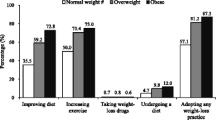Abstract
Obesity in children seems to be a risk factor for chronic diseases in adulthood. From the viewpoint of preventive medicine, factors influencing the development of obese children should be removed early in life.
The purpose of this study was to the elucidate relationship between obesity in 3-year-old children and both behavioral and environmental factors by conducting a case-control study. Subjects were selected from the Toyama study. Matched-pair comparisons were performed between obese children whose Kaup’s index was 18 or more (N=117) and control children (N=234) . Multivariate stepwised logistic regression analysis also applied to assess influence of confounding factors.
The results indicated that the following 6 factors significantly influenced the development of obese 3-year-old children in exact Fisher’s method analysis (p<0.05): person other than the mother responsible for taking care of the child, short sleep duration (9 hours or less), physical inactivity, eating snacks irregularly, overweight father (BMI≥24), and overweight mother (BMI≥24). For both sexes, after adjusting for confounders by multivariate stepwise logistic analysis, overweight mother (OR 2.54, 95 % CI 1.64-3.95), birth overweight (birth weight≥3,500g; OR 1.76, 95 % CI 1.15-2.69), the mother not responsible for taking care of the child (OR 1.65, 95% CI 1.10-2.48), overweight father (OR 1.62, 95%CI 1.09-2.40), eating snacks irregularly (OR 1.56, 95% CI 1.04-2.33), and gender (female;OR 0.51, 95% CI 0.34-0.77) had significant relationships with obesity in childhood. For boys, overweight mother (OR 2.53, 95 % CI 1.47-4.35), birth overweight (OR 2.03, 95%CI 1.22-3.39), eating snacks irregularly (OR 1.94, 95 %CI 1.19-3.18), and birth month (36-41 months; OR 0.47, 95 % CI 0.23-0.96) had significant relationships. For girls, overweight mother (OR 2.62, 1.28-5.35), and short sleep duration (OR 2.24, 1.11-4.52) had significant relationships. In neither Fisher’s exact method nor multivariate logistic models, time to wake up, bedtime, duration of playing outdoors, regularity of meals, care about salty food, or frequency of eating snacks had significant relations with obesity in 3-year-old children (p<0.05).
Similar content being viewed by others
References
Yoshida K, Miyakawa M, Kondo T. Epidemiological analysis of behavior and lifestyles in Toyama study. Psychosomatic disturbance research“Research concerning prevention of chronic disease from childhood” March 1992. Ministry of Health and Welfare, Japan.
Yamagami T, Naruse M, Kagamimori S. Report of establishment andproceeding in Toyama study, Psychosomatic disturbance research“Research concerning prevention of chronic disease from childhood” March 1992. Ministry of Health and Welfare, Japan.
Berenson GS, Srinivasan SR, Hunter SM, Nicklas TA, Freedman DS,Shear CL, et al. Risk factors in early life as predictors of adult heart disease: The Bogalusa heart study. Am J Med Sci 1989;298: 141–51.
Locard E, Mamelle N, Bilette A, Miginiac M, Munoz F, Rey S. Riskfactors of obesity in a five year old population. Parental versus environmental factors. Int J Obes 1992;16: 721–9.
SAS Institute Inc. SAS User’s Guide Statistics, Version 6 First Edition. Cary, North Carolina: SAS Institute Inc., 1993.
Okishi M, Ikeda H, Matsuda M, Matsumoto T, Kiya K, Adachi I, et al. Study concerning behavior and lifestyles of nursery shooler and kindergartner. -Research concerning development of methods which effectively elucidate risk factors of chronic disease in childhood-Psychosomaticdisturbance research “Research concerning prevention of chronic diseasefrom childhood” 1989. Ministry of Health and Welfare, Japan.
Veldhuis JD, Iranmanesh A, Ho KKY, Waters MJ, Johnson ML,Lizarralde G, et al. Dual defects in pulsate growth hormone secretionand clearance subserve the hyposomatotropism of obesity in man. J Clin Endocrinol Metab 1991;72: 51–9.
Gam SM, LaVelle M. Two-decade follow-up of fatness in early childhood. Am J Dis Child 1985;139: 181–5.
Mossberg HO. 40-year follow-up of overweight children. Lancet 1989;334 (II): 491–3.
Borjeson M. The aetiology of obesity in children-a study of 101 twinpairs. Acta Paediatr Scand 1976;65: 279–87.
Greenlund KJ, Liu Kiang, Dyer AR, Kiefe CI, Burke GL, Yunis C. Body mass index in young adults: Associations with parental body sizeand education in the CARDIA study. Am J Public Health 1996;86: 480–5.
Binkin NJ, Yip R, Freshood L, Trowbridge FL. Birth weight and childhood growth. Pediatrics 1988;82: 828–34.
Muramatsu S, Sato Y, Miyao M, Muramatsu T, Ito A. A longitudinalstudy of obesity in Japan: Relationship of body habitus between at birthand age 17. Int J Obes 1990;14: 39–45.
Author information
Authors and Affiliations
Rights and permissions
About this article
Cite this article
Sugimori, H., Yoshida, K., Miyakawa, M. et al. Influence of Behavioral and Environmental Factors on the Development of Obesity in Three-year-old Children —A Case-Control Study Based on Toyama Study—. Environ Health Prev Med 2, 74–78 (1997). https://doi.org/10.1007/BF02931968
Received:
Accepted:
Issue Date:
DOI: https://doi.org/10.1007/BF02931968




